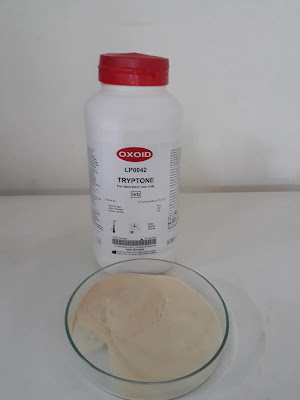PRODUCT IDENTIFICATION
- What do I need to Read before – It’s Tryptone SDS!
- Product Name: Tryptone.
- Cat Number: LP0042.
- Cas Number: 73049-73-7.
- Synonym: Not available.
- Recommended Usage: Lab. Chemicals.
HAZARD IDENTIFICATION
- According to GHS classifications for the Hazard Communication Standard, this chemical is not considered hazardous. All laboratory substances should be handled with care.
- Although this substance is thought to be nonhazardous, unanticipated chemical reactions are always a possibility. Laboratory procedures should be followed carefully.
COMPOSITION/INFORMATION ON INGREDIENTS
- Component: Trypton.
- Weight %: 100.
FIRST-AID MEASURES
- Eye Contact: Rinse your body completely, being sure to get under your eyelashes. Consult a specialist if eye inflammation persists.
- Skin Contact: Use soap & warm water to rinse off.
- Ingestion: Get outside & breathe some fresh air.
- Notes to the Doctor: Use symptomatic treatment.
FIRE-FIGHTING MEASURES
- Suitable Extinguishing Media: Utilize extinguishing techniques that are suitable for the local climate & surroundings.
- Extinguishing media which must not be used for safety reasons: No information is available.
- Specific Hazards Arising from the Chemical: In the air, dust can create an explosive combination.
- Protective Equipment & Precautions for Firefighters: Wear self-contained breathing apparatus pressure-demand, MSHA/NIOSH (certified or equivalent), & all necessary safety gear whenever there is a fire.
- Flash Point: Not applicable
- Method: No information available.
- Autoignition Temperature: No information available.
ACCIDENTAL RELEASE MEASURES
- Personal Precautions: Make sure there is enough airflow.
- Environmental Precautions: Environmental safeguards If it’s safe, stop any further leaks or spills.
- Techniques for Cleaning Up & Containment: Avoid creating dust Spills should be swept up or vacuumed up, then collected in an appropriate receptacle for disposal.
HANDLING & STORAGE
- Handling: Make sure there is enough airflow.
- Storage: Maintain the container in a dry, well-ventilated area with the lid well shut.
- Specific use: No data available.
EXPOSURE CONTROLS / PERSONAL PROTECTION
- Exposure Limits: There are no hazardous elements in the product with specified occupational exposure limits.
- Engineering Measures: Make sure there is enough ventilation, especially in small spaces.
- Respiratory Protection: Observe the European Standard EN 149 or the OSHA respirator requirements specified in 29 CFR 1910.134. Use a respirator that has been approved by NIOSH/MSHA or European Standard EN 149 if exposure limits are breached, or if irritation or other symptoms are felt.
- Eye Protection: safety glasses that are snugly fitted.
- Body & Skin Protection: To avoid skin exposure, put on protective gloves & outerwear.
- Hygiene Measures: Utilize safe handling techniques & adhere to excellent industrial hygiene standards.
- Environmental Exposure Control: No info. Available.
PHYSICAL & CHEMICAL PROPERTIES
- Physical State: Powder.
- Odor: Malt-like.
- pH: Not applicable.
- Boiling Point/Range: Not applicable.
- Melting Point/Range No information available.
- Flash Point: Not applicable.
- Solubility: water.
STABILITY & REACTIVITY
- Stability: It’s stable under recommended storage conditions. Hygroscopic.
- Conditions to Avoid: Exposure to moistness.
- Incompatible Materials: Strong-Oxidizing agents
- Hazardous Decomposition Products: None under normal usage.
- Hazardous Polymerization: No information available.
- Hazardous Reactions: None under the normal process.
TOXICOLOGICAL INFORMATION
- Based on the information that is currently known or available, the product does not pose a risk for acute toxicity.
- Carcinogenicity: This product has no known carcinogenic substances.
- Sensitization: No information available.
- Neurological Effects: No info. available.
- Mutagenic Effects: No info. available.
- Reproductive Effects: No info. available.
- Developmental Effects: No info. available.
- Target Organs: No info. available.
ECOLOGICAL INFORMATION
- Ecotoxicity: No compounds that are known to be harmful to the environment or that cannot be broken down in wastewater treatment facilities are present.
- Persistence and Degradability: No information is available.
- Bioaccumulative Potential: No info. available.
- Mobility: No info. available.
DISPOSAL CONSIDERATIONS
- Waste from Residues / Unused
Products: Dispose of according to local regulations. - Contaminated Packaging: Empty containers should be taken for local waste disposal, recycling, and resource recovery.
TRANSPORT INFORMATION
- Not regulated.
REGULATORY INFORMATION
- According to EC-directives 67/548/EEC & 1999/45/EC, neither a hazardous substance nor preparation.
OTHER INFORMATION
- Disclaimer: To the best of our knowledge, information, & belief as of the publishing date, the material on this Safety Data Sheet is accurate. The provided information is not to be construed as a warranty or quality specification, but rather as a reference for safe handling, use, processing, storage, transit, disposal, & release. Unless specifically stated in the text, the information is limited to the identified substance and may not be applicable when that material is combined with other materials or used in other processes.

Tryptone is a complex protein hydrolysate derived from casein(Milk Protein), commonly used in microbiology as a growth medium for bacteria. It is a mixture of peptides, amino acids & small amounts of other nitrogenous compounds.
CONCLUSION
Tryptone is a casein-derived complex protein hydrolysate that is frequently used in microbiology as a bacterial growth medium. When carrying out necessary laboratory precautions & protocols, such as donning the proper personal protective equipment, identifying the substance properly, and disposing of it properly, it is typically safe to handle. When handling any laboratory reagent, including Tryptone, it’s crucial to constantly adhere to excellent laboratory practices, & standard operating procedures, & wear the appropriate personal protection equipment. Please seek emergency medical assistance if any unfavourable reaction takes place. It is neither combustible nor explosive, & you can put out a fire with water, foam, or CO2. People should also be aware of any potential allergens in the material & treat them appropriately. Tryptone should be treated carefully because some people could respond allergic to it. Before handling this product, One must read Tryptone SDS!
